Accidents and injuries are unfortunately not uncommon in childhood, with falls, collisions, or car accidents frequently leading to various types of harm. One such injury that is often overlooked, especially in younger individuals, is whiplash. Whiplash is a neck injury resulting from forceful, rapid back-and-forth movement of the neck, akin to the cracking of a whip. Despite the fact that it’s frequently associated with vehicle accidents, it can result from a variety of other situations, such as sports incidents, physical abuse, or even amusement park rides.
In children, the identification, diagnosis, and treatment of whiplash can be slightly different than in adults due to their unique anatomy and physiology. This blog post will walk you through the process of recognizing whiplash in children, understanding the potential complications, and exploring the various treatment options available.
What is Whiplash?
Whiplash is a non-medical term often used to describe a range of neck injuries resulting from or related to a sudden distortion of the neck associated with extension. It is also called neck sprain or neck strain, caused by a sudden force that results in an unrestrained, rapid back-and-forth movement of the neck and head, much like the cracking of a whip, hence the term “whiplash”.
The Vulnerability of Children to Whiplash
Contrary to common belief, children are not just small adults. Their bodies are still developing, and their anatomy is distinctly different. This, coupled with their lifestyle and certain activities, makes them more prone to injuries, including whiplash.
Children’s heads are disproportionately larger compared to their bodies. This increased head-to-body ratio can increase the whip effect on the neck during sudden movements or impacts, causing more pronounced injury.
Moreover, their musculoskeletal system, including the neck region, is still developing. Their muscles and ligaments are not as strong as adults, and the cervical spine and surrounding structures are not fully matured, increasing the likelihood of injury from forces that might not cause harm in adults.
Recognizing Whiplash Injuries in Children
Recognizing whiplash in children at Beaverton Family Chiropractic in Beaverton can be challenging, as they may not always be able to communicate their symptoms effectively. It is essential for parents, caregivers, and healthcare professionals to be vigilant for any changes in a child’s behavior or physical condition following an accident or injury. Common signs and symptoms of whiplash in children may include:
- Neck pain and stiffness
Children may complain of pain or discomfort in the neck area. They may find it difficult to turn their head or experience stiffness when moving their neck.
- Headaches
Children may experience frequent headaches, which may be persistent or intermittent.
- Changes in behavior
Whiplash can cause irritability, difficulty concentrating, changes in sleep patterns, and mood swings in children.
- Fatigue
Children may feel tired or fatigued more easily than usual.
- Dizziness
Some children may experience dizziness or lightheadedness following a whiplash injury.
- Sensory disturbances
Whiplash can sometimes lead to sensory disturbances, such as tingling or numbness in the arms or hands.
Complications of Whiplash in Children
While many children with whiplash recover within a few weeks, some might continue to have chronic neck pain and other long-lasting complications. Chronic symptoms can cause children to miss school and other activities, which can be emotionally challenging.
Additionally, if left untreated, whiplash could potentially lead to early-onset arthritis in the neck. This is why recognizing the symptoms and seeking immediate medical attention is crucial to prevent long-term damage and ensure a full recovery.
Diagnosing Whiplash in Children
If whiplash is suspected, it’s crucial to seek medical attention immediately. The doctor will perform a thorough examination, which might include:
Medical History: This includes details about how the injury happened, the child’s symptoms, and any past neck or head injuries.
Physical Examination: The doctor will check for physical signs of injury, such as tenderness, and assess the child’s range of motion and reflexes.
Imaging Tests: In some cases, the doctor may order imaging tests such as X-rays, CT scans, or MRIs to assess the extent of the injury and rule out other conditions.
Treatment Options for Whiplash in Beaverton
When it comes to treating whiplash in children, a comprehensive approach that addresses both the physical and emotional aspects of the injury is crucial. Here are some common treatment options:
Rest and activity modification: Initially, children with whiplash may require rest and limited physical activity to allow the injured tissues to heal. Gradually, a healthcare professional may recommend gentle exercises and stretches to improve range of motion and promote healing.
Physical therapy: Physical therapy exercises and techniques can help strengthen the neck muscles, improve range of motion, and reduce pain in children with whiplash.
Chiropractic care: Chiropractic care is a safe and effective treatment option for children with whiplash. Chiropractors are trained to evaluate and treat musculoskeletal injuries, including whiplash. They may use gentle spinal adjustments, manual therapies, and other techniques to help alleviate pain, improve mobility, and promote healing.
Counseling and support: Whiplash injuries can have emotional effects on children. Counseling or therapy sessions can help children cope with the psychological impact of the injury and provide support during their recovery.
Long-Term Prognosis and Prevention for Whiplash
The majority of children with whiplash recover within a few weeks to months with appropriate treatment. However, in some cases, children may continue to experience symptoms like neck pain and headaches for a year or more, a condition known as post-concussion syndrome.
Prevention is always the best strategy. Ensure children use the appropriate safety equipment and follow safe practices during sports and other activities. Car safety is also crucial; always use age-appropriate car seats and booster seats, and ensure children always wear seat belts.
Whiplash Treatment for Children in Beaverton
In conclusion, recognizing and treating whiplash in children is of utmost importance to ensure their well-being and healthy development. At Beaverton Family Chiropractic, located in Beaverton, we understand the unique challenges of addressing whiplash injuries in younger individuals. If you suspect your child may have suffered from whiplash due to an accident or injury, do not hesitate to seek professional help. Give us a call at (503) 644-8844, and our experienced chiropractors will provide a comprehensive evaluation and personalized treatment plan to address the specific needs of your child.
Visiting a chiropractor is crucial in the recovery process because they are specially trained to treat musculoskeletal injuries like whiplash. Chiropractic care offers a safe, non-invasive, drug-free approach to alleviate pain, improve mobility, and promote healing in children. Our team at Beaverton Family Chiropractic is dedicated to providing gentle and effective chiropractic adjustments and therapies that prioritize your child’s comfort and well-being. Early intervention can prevent long-term complications, allowing your child to regain their active and joyful lifestyle. Trust Beaverton Family Chiropractic with your child’s whiplash treatment, and let us help them on their path to a healthy and pain-free future.




